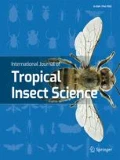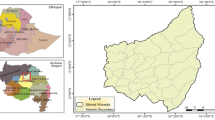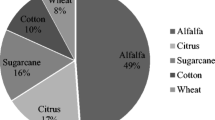Abstract
Soil Arthropods are a vitally important component of the ecosystem, as their diversity, abundance, and distribution pattern play a vital role in ecosystem sustainability. Their population is expected to vary according to geographical patterns and environmental variables such as temperature, and humidity. For this purpose, we collected soil arthropods from the two regions having different latitudinal patterns: FSD (Faisalabad) and MGRH (Muzaffargarh). The soil faunal samples were collected fortnightly from the mango orchards for two consecutive years, 2017 and 2018. During the whole research, a total of 8301 specimens of (16, 11) orders, (118, 57) species, and (5027, 3274) individuals were recorded from FSD and MGRH, respectively. Order Coleoptera found the maximum abundance in both regions among all orders. Our results showed that the FSD regions had a high abundance of arthropods compared to the MGRH region. In comparison, the different diversity factors and abundance revealed a strong correlation with the abiotic factors. They showed a high pattern of distribution and richness at the FSD region, as low temperature and high humidity were observed in the FSD region that influences the more diversity occurrence of fauna. Our results predicted that the habitat type and environmental factors such as humidity and temperature play a significant role in the distribution pattern of arthropods in any geographical region.


Similar content being viewed by others
References
Andrew NR (2013) Population dynamics of insect populations: impacts of a changing climate. In: Rohde K (ed) The balance of nature and climate change. Cambridge University Press, Cambridge, pp 311–324
Antao LH, McGill B, Magurran AE, Soares AM, Dornelas M (2019) β-Diversity scaling patterns are consistent across metrics and taxa. Ecography 42:1012–1023
AntWeb (2018) Version 8.40. California Academy of Science, online at https://www.antweb.org. Accessed Oct 2018
Antwiki (2018) https://www.antwiki.org/wiki/Ant_Identification. Accessed Oct 2018
Bagchi R, Gallery RE, Gripenberg S, Gurr SJ, Narayan L, Addis CE, Freckleton RP, Lewis OT (2014) Pathogens and insect herbivores drive rainforest plant diversity and composition. Nature 506:85–88
Barberi GB, Dinelli G, Moonen AC, Otto S, Vazzana C, Zanin G (2010) Functional biodiversity in the agricultural landscape: relationships between weeds and arthropod fauna. Weed Res 50:388–401
Basset Y, Corbara B, Barrios H, Cuénoud P, Leponce M, Aberlenc HP, Bail J, Bito D, Bridle JR, Castano Meneses G, Cizek L (2007) IBISCA-Panama, a large-scale study of arthropod beta-diversity and vertical stratification in a lowland rainforest: rationale, description of study sites and field methodology. Bulletin de l'Institut Royal Des Sciences Naturelles de Belgique Entomologie 77:39–70
Biaggini M, Consorti R, Dapporto L, Dellacasa M, Paggetti E, Corti C (2007) The taxonomic level order as a possible tool for rapid assessment of arthropod diversity in agricultural landscapes. Agric Ecosyst Environ 122:183–191
Blankinship JC, Niklaus PA, Hungate BA (2011) A meta-analysis of responses of soil biota to global change. Oecologia 165:553–565
Borror DJ, Delong DM (1970) An introduction to the study of insects (3rd Ed.). pp. 110-158. Ohio State University, USA
Caruso T, Schaefer I, Monson F, Keith AM (2019) Oribatid mites show how climate and latitudinal gradients in organic matter can drive large-scale biodiversity patterns of soil communities. J Biogeogr 46:611–620
Cesarz S, Ciobanu M, Wright AJ, Ebeling A, Vogel A, Weisser WW, Eisenhauer N (2017) Plant species richness sustains higher trophic levels of soil nematode communities after consecutive environmental perturbations. Oecologia 184:715–728
Clark WC, van Kerkhoff L, Lebel L, Gallopin GC (2016) Crafting usable knowledge for sustainable development. Proceed Nat Acad Sci USA 113:4570–4578
de Sassi C, Lewis OT, Tylianakis JM (2012) Plant-mediated and nonadditive effects of two global change drivers on an insect herbivore community. Ecology 93:1892–1901
Derraik JGB, Early JW, Closs GP, Dickinson KJM (2010) Morphospecies and taxonomic species comparison for Hymenoptera. J Insect Sci 10:108
Eisenhauer N, Antunes PM, Bennett AE, Birkhofer A, Bissett A, Bowker MA, Caruso T (2017) Priorities for research in soil ecology. Pedobiologia 63:1–7
Franca LF, Figueiredo-Paixao VH, Duarte-Silva TA, Santos KBD (2020) The effects of rainfall and arthropod abundance on breeding season of insectivorous birds, in a semi-arid neotropical environment. Zoologia 37:1–7
Goddard MA, Dougill AJ, Benton TG (2010) Scaling up from gardens: biodiversityconservation in urban environments. Trends Ecol Evol 25:90–98
GOP (2016) City district government Muzaffargarh and Faisalabad. Pakistan
Hamblin AL, Youngsteadt E, Lopez-Uribe MM, Frank SD (2017) Physiological thermal limits predict differential responses of bees to urban heat island effect. Biol Lett 13:01–25
IPBES (2019) Summary for policymakers of the global assessment report on biodiversity and ecosystem services of the intergovernmental science policy platform on biodiversity and ecosystem services. pp. 56. S. Díaz, J. Settele, E. S. Brondízio, H. T. Ngo, M. Guèze, J. Agard, C. N. Zayas(Eds.). Bonn, Germany: IPBES Secretariat
IPCC (2014) Climate change 2014: impacts, adaptation, and vulnerability. Part a: global and sectoral aspects. Contribution of working group II to the fifth assessment report of the intergovernmental panel on climate change. Field CB, Barros VR, Dokken DJ, Mach KJ, Mastrandrea MD, Bilir TE, White LL (Eds.). Cambridge: Cambridge University Press
Jabbour R, Pisani-Gareau T, Smith RG, Mullen C, Barbercheck M (2016) Cover crop and tillage intensities alter ground-dwelling arthropod communities during the transition to organic production. Renew Agricult Food Syst 31:361–374
Jacobsen GJ, Moraes H, Sorensen L, Sigsgaard (2019) Organic cropping practice decreases pest abundance and positively influences predator-prey interactions. Agric Ecosyst Environ 272:1–9
Khan NI, Malik AU, Umer F, Bodla MI (2010) Effect of tillage and farmyard manure on physical properties of soil. Int J Plant Sci 1:75–82
Knapp AK, Beier C, Briske CC, Classen AT, Luo Y, Reichstein M, Smith MD, Smith SD, Bell JE, Fay PA, Heisler JL, Leavitt SW, Sherry R, Smith B, Weng E (2008) Consequences of more extreme precipitation regimes for terrestrial ecosystems. BioScience 58:811–821
Koricheva J, Mulder CP, Schmid B, Joshi J, Huss-Danell K (2000) Numerical responses of different trophic groups of invertebrates to manipulations of plant diversity in grasslands. Oecologia 125:271–282
Landesman WJ, Treonis AM, Dighton J (2011) Effects of a one-year rainfall manipulation on soil nematode abundances and community composition. Pedobiologia 54:87–91
Leckey EH, Smith DM, Nufio CR, Fornash KF (2014) Oak-insect herbivore interactions along a temperature and precipitation gradient. Acta Oecol 61:1–8
Lomolino MV, Riddle BR, Whittaker RJ, Brown JH (2010) Biogeography, 4th edn. Sinauer Associates Inc., Sunderland
Macedo-Reis LE, Quesada M, Neves FS (2019) Forest cover drives insect guild diversity at different landscape scales in tropical dry forests. Forest Ecol Manag 443:36–42
Magurran AE (1988) Ecological diversity and its management. Princeton University Press, Princeton, pp 34–37
Magurran AE, Deacon AE, Moyes F, Shimadzu H, Dornelas M, Phillip DAT, Ramnarine IW (2018) Divergent biodiversity change within ecosystems. Proceed Nat Acad Sci USA 115:1843–1847
Majeed W, Rana N, de Azevedo Koch EB, Nargis S (2020) Seasonality and climatic factors affect diversity and distribution of arthropods around wetlands. Pak J Zool 52:2135–2144
Maqsood S, Rana N, Majeed W, Nargis S (2020) Effect of dawn and dusk on the diversity and abundance of arthropods in a mixed agroecosystem. Pak J Agric Sci 57:975–980. https://doi.org/10.21162/PAKJAS/20.5
Mathieu J (2018) Growth: a global database on intraspecific body growth variability in earthworm. Soil Biol Biochem 122:71–80
Mayor AG, Bautista S, Rodriguez F, Kéfi S (2019) Connectivity-mediated ecohydrological feedbacks and regime shifts in drylands. Ecosystems 22:1497–1511
McGlynn TP, Meineke EK, Bahlai CA, Li E, Hartop EA, Adams BJ, Brown BV (2019) Temperature accounts for the biodiversity of a hyper diverse group of insects in urban Los Angeles. Proceed R Soc 286:20191818
Moreira X, Petry WK, Mooney KA, Rasmann S, Abdala-Roberts L (2018) Elevational gradients in plant defences and insect herbivory: recent advances in the field and prospects for future research. Ecography 41:1485–1496
Naseem R, Rana N, Koch EBA, Majeed W, Nargis S (2020) Abundance and diversity of foliage insects among different olericulture crops. GSC Biol Pharmaceut Sci 10:62–69
Pincebourde S, Van Baaren J, Rasmann S, Rasmont P, Rodet G, Martinet B, Calatayud PA (2017) Plant–insect interactions in a changing world. Adv Bot Res 81:289–332
Rafi MA, Irshad M, Inyatullah M (2005) Predatory ladybird beetles of Pakistan, 1st edn. National Agriculture Research Center, Islambad, pp 16–50
Rana N, Rana SA, Khan HA, Sohail A (2010) Assessment of handicaps owing to high input (hip) farming on the soil macroinvertebrates’ diversity in sugarcane field. Pak J Agric Sci 47:271–278
Rana N, Saleem M, Majeed W, Jalal F, Ehsan N, Nargis S (2019) Diversity of arthropods regarding habitat specialty in agro-ecosystem of Faisalabad Pakistan. GSC Biol Pharmaceut Sci 6:1–8
Saenz-Romo MA, Veas-Bernal A, Martinez-Garciaa H, Campos-Herrerab R, Ibanez-Pascualb S, Martínez-Villara E, Pérez-Morenoa I, Marco-Mancebon VS (2019) Ground cover management in a Mediterranean vineyard: impact on insect abundance and diversity. Agric Ecosyst Environ 283:106571
Shannon CE (1948) A mathematical theory of communication. J Bell Syst Tech 27:379–423
Simao FCP, Carretero MA, Amaral MJA, Soares AMV, Mateos E (2015) Composition and seasonal variation of epigeic arthropods in field margins of NW Portugal. Turk J Zool 39:404–411
Soininen J, Heino J, Wang J (2018) A meta-analysis of nestedness and turn over components of beta diversity across organisms and ecosystems. Glob Ecol Biogeogr 27:96–109
Sommaggio D, Peretti E, Burgio G (2018) The effect of cover plants management on soil invertebrate fauna in vineyard in northern Italy. BioControl 63:795–806
Steel RGD, Torrie JH, Dicky DA (1997) Principles and procedures of statistics, a biometrical approach, 3rd edn. Inc. Book Co., McGraw Hill, pp 352–358
Stephanie I, Rasmont P (2012) The effect of climatic variation on abundance and diversity of bumblebees: a ten years survey in a mountain hotspot. Annales de la Societe Entomologique de France 48:261–273
Suheriyanto D, Soemarno B, Yanuwiadi AS, Leksono DH, Prasetiyo PSR (2019) Effects of season on abundance and diversity of soil arthropods in mangli coffee plantation Kediri regency, East Java, Indonesia. Int J Engineer Technol 8:131–135
Sylvain ZA, Wall DH, Cherwin KL, Peters DPC, Reichmann LG, Sala OE (2014) Soil animal responses to moisture availability are largely scale, not ecosystem dependent: insight from a cross-site study. Glob Chang Biol 20:2631–2643
Thompson RM, Brose U, Dunne J, Hall RO, Hladyz S, Kitching RL, Martinez ND, Rantala H, Romanuk TN, Stouffer DB, Tylianakis JM (2012) Food webs: reconciling the structure and function of biodiversity. Trends Ecol Evol 27:689–697
Torma PC, Bozso M, Deak B, Valko O, Kiss O, Galle R (2019) Species and functional diversity of arthropod assemblages (Araneae, Carabidae, Heteroptera and Orthoptera) in grazed and mown salt grasslands. Agric Ecosyst Environ 273:70–79
Torode M, Barnett KL, Facey SL, Nielsen U, Power S, Johnson SNJ (2016) Altered precipitation impacts on above- and belowground grassland invertebrates: summer drought leads to outbreaks in spring. Front Plant Sci 7:1468
Triplehorn CA, Johnson NF, Borror DJ (2005) Borror and Delong’s introduction to study of insects, 7th edn. Brooks Thomson Cole USA, Little Rock, p 879
Turnbull MS, Lindo Z (2015) Combined effects of abiotic factors on Collembola communities reveal precipitation may act as a disturbance. Soil Biol Biochem 82:36–43
Ulrich W, Fiera C (2010) Environmental correlates of body size distributions of European springtails (Hexapoda: collembola). Glob Ecol Biogeogr 19:905–915
Wheeler MM, Neill C, Groffman PM, Avolio M, Bettez N, Cavender-Bares J, Chowdhury RR, Darling L, Grove JM, Hall SJ (2017) Continental-scale homogenization of residential lawn plant communities. Landsc Urban Plan 165:54–63
Wong MKL, Guenard B, Lewis OT (2018) Trait-based ecology of terrestrial arthropods. Biol Rev 94:999–1022
Xu X, Sherry RA, Niu S, Li D, Luo Y (2013) Net primary productivity and rain-use efficiency as affected by warming, altered precipitation, and clipping in a mixed-grass prairie. Glob Chang Biol 19:2753–2764
Acknowledgements
We acknowledge Dr. Elise F. Zipkin from the Department of Integrative Biology, College of Natural Science, Michigan State University, USA, for providing keen help and resources in research analysis and Biodiversity Laboratory, University of Agriculture, Faisalabad, Pakistan, for providing the platform for research.
Author information
Authors and Affiliations
Corresponding author
Ethics declarations
Conflict of interest
The authors declare that they have no conflict of interest.
Additional information
Publisher’s note
Springer Nature remains neutral with regard to jurisdictional claims in published maps and institutional affiliations.
Rights and permissions
About this article
Cite this article
Nargis, S., Rana, N., Khan, M.A. et al. Variation of soil arthropods abundance and diversity between two sites of the Punjab province in Pakistan. Int J Trop Insect Sci 41, 1739–1746 (2021). https://doi.org/10.1007/s42690-020-00379-2
Received:
Accepted:
Published:
Issue Date:
DOI: https://doi.org/10.1007/s42690-020-00379-2




